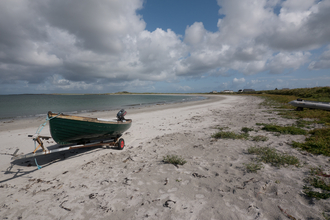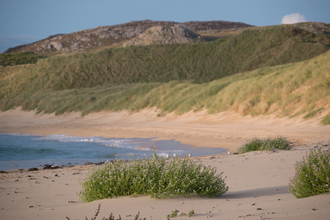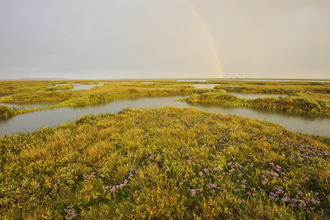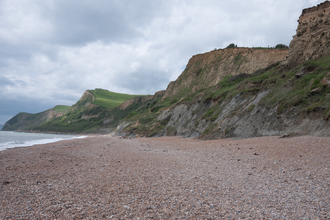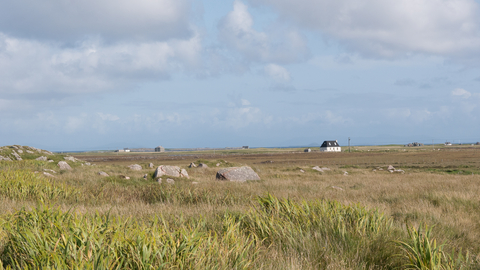
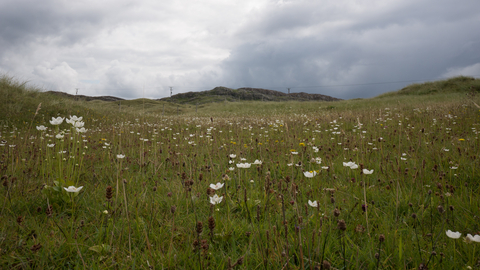
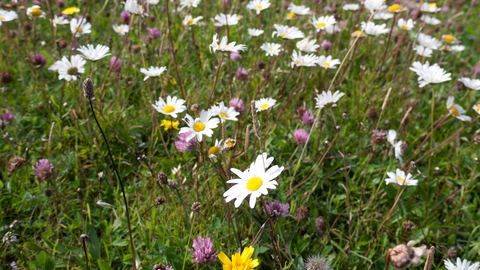
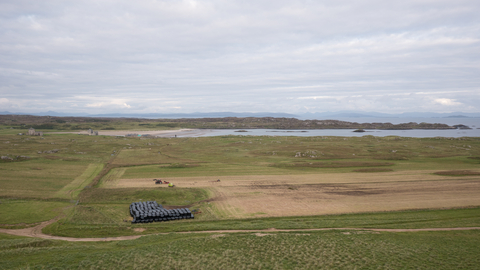
Machair
Beth yw o?
A Gaelic word meaning fertile, low-lying grassy plain, ‘machair’ refers to a unique habitat that is one of the rarest in Europe; only occurring on the exposed west-facing shores of Scotland and Ireland. Machair habitat is very similar to a fixed sand dune but is easily distinguished by its flat, or gently undulating landscape, and the variety of vegetation types and land-uses.
Common flowers (such as red clover, bird’s-foot-trefoil, yarrow and daisies) grow a lot here, along with a few rarer species such as lesser-butterfly orchid, Hebridean spotted orchid, marsh orchid and, on Coll and Barra, Irish lady’s-tresses. Wet hollows hold iris beds, while frequent damp patches support silverweed and ragged-Robin. Some areas are used for farming (e.g. for oats and rye) on rotation, and fallow plots may contain corn marigold, field pansy and poppies. Other areas are used as hay meadows.
Inland, wetter machair vegetation gives way to marsh and swamp on the shores of lochs and forms transitions to moorland and blanket bog on the “blacklands”, where sand is blown over peat.
Pam fod o fel hyn?
Machair is formed from lime-rich shell sand washed up thousands of years ago by the sea, and eroded from dunes by powerful winds, spreading the sand well inland. Light cattle-grazing, hay cutting and low intensity rotational crop farming (free of artificial fertilisers or pesticides) has shaped the landscape over millenia.
Dosbarthiad yn y DU
Machair is only found in north and west Scotland and western Ireland and occurs nowhere else on the globe!
Beth i edrych am
Visit between April and June for breeding waders, particularly lapwing, but also redshank, snipe and dunlin in wetter areas and oystercatcher and ringed plover on ploughed areas. The secretive corncrake can be hard to see, but its distinctive “crex crex” call is easily heard both by day and by night. Listen, too, for the energetic calls of twite. June and July see the floral displays come in to their own, providing nectar for plenty of invertebrates, including rare bees like the greater yellow bumblebee and the red-shanked carder bee.
Cadwraeth
Machair is a result of the interplay of crofting culture (a form of land tenure and small-scale food production particular to Scotland), landscape and wildlife, and is dependent on low-intensity farming that is increasingly difficult to sustain. Machair cultivation now only really occurs on the Uists, and traditional methods are facing economic challenges, largely shifting to year-round grazing with sheep rather than cattle, earlier hay cuts or conversation to silage, drainage, and increased use of artificial fertilisation. Add to this a loss of variety in the way machair is managed, and its future now depends on support through agri-environment funding.

